In most of the United States we think of summer as the seasonfor outdoor fun: swimming, boating and grilling, among otherthings.
|For those along the East Coast and the Gulf Coast, summer isalso known as hurricane season. But in Arizona, California, Nevada,New Mexico, Oklahoma and Texas June and July are known as peak duststorm or “haboob” season, even though such storms can occur atother times of the year as well.
|According to the National Oceanic and AtmosphericAdministration (NOAA), haboobs are very strong dust and sandstorms that move through hot and dry regions. They are common inarid regions such as the Sahara desert, the Arabian Peninsula,North Africa and the Gulf of Guinea.
|Related: 8ways to prepare your insureds for a disaster
|As NOAA explains, haboobs form when air is forced down andpushed forward by the front of a traveling thunderstorm cell, itdrags with it dust and debris. Winds of speeds up to 60 mph canstir up dust and sand and create a blowing wall as high as 10,000feet. Haboobs usually last only 10 to 30 minutes, but on rareoccasions can last longer and create hazardous conditions forground transportation systems, air traffic and motorists.
|Here are 10 things you and your clients need to know about duststorms, safety and insurance coverage:
|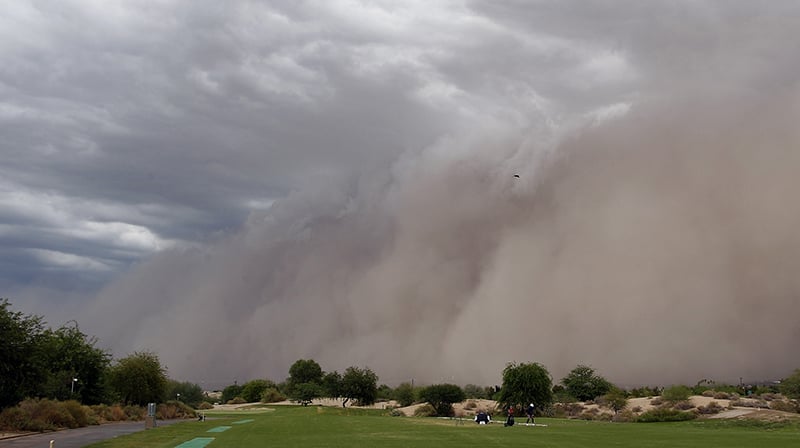
In this July 29, 2016, file photo, a sand storm hits thePhoenix metro area in Laveen, Ariz. Arizona Department ofTransportation engineers are beginning design work on a dustdetection and warning system for Interstate 10 between Tucson andPhoenix where dust storms often develop suddenly. (AP Photo/Ross D.Franklin, File)
|1. How often do dust storms happen?
The general frequency of dust storms in the United States andthe resulting damage are increasing, and they're expected tocontinue to increase in frequency.
|Arizona gets about three haboobs per year and smaller duststorms more frequently. A recent report from NOAA, based on statisticsfrom 1955 through 2013, found that blowing dust was the thirddeadliest weather phenomenon in Arizona after flooding and extremeheat and cold.
|Related: 6 keys to successfully weathering thestorm
|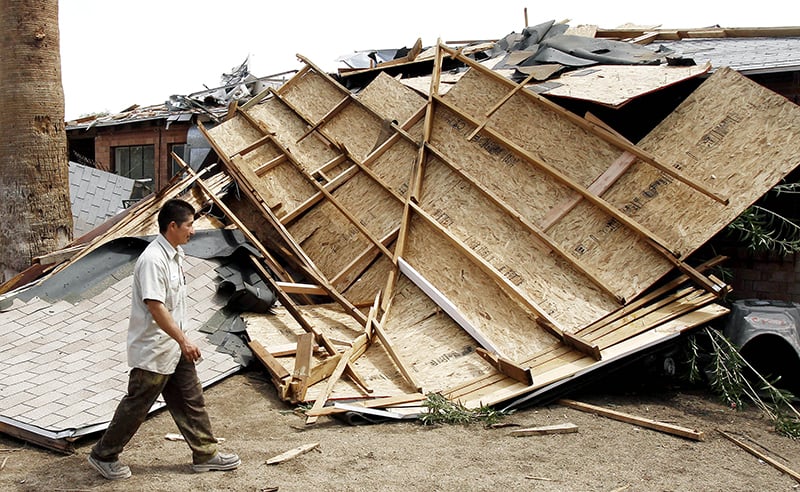
Rudy Procela, of Eloy, Ariz., surveys the damage caused tohis home after a neighbor's roof ripped through his property theday after a violent storm hit the area Aug. 19, 2011, in Eloy. (APPhoto/Ross D. Franklin)
|2. What are the most commondangers?
Almost anything can happen in a severe weather event, aswe've seen with thunderstorms, lightning strikes andtornadoes. The most common dangers you personally can face fromdust storms are:
- Quick and complete loss of visibility,
- Unsafe breathing conditions,
- Unsafe flying and driving conditions,
- Flying debris, and
- A lack of warning.
To make matters worse, dust storms, which are a result ofthunderstorm activity, are often accompanied by heavy rain or mudstorms. In addition, the risk of lightning and fire isincreased.
|Related: Changing weather patterns mean homeowners need torethink risks
|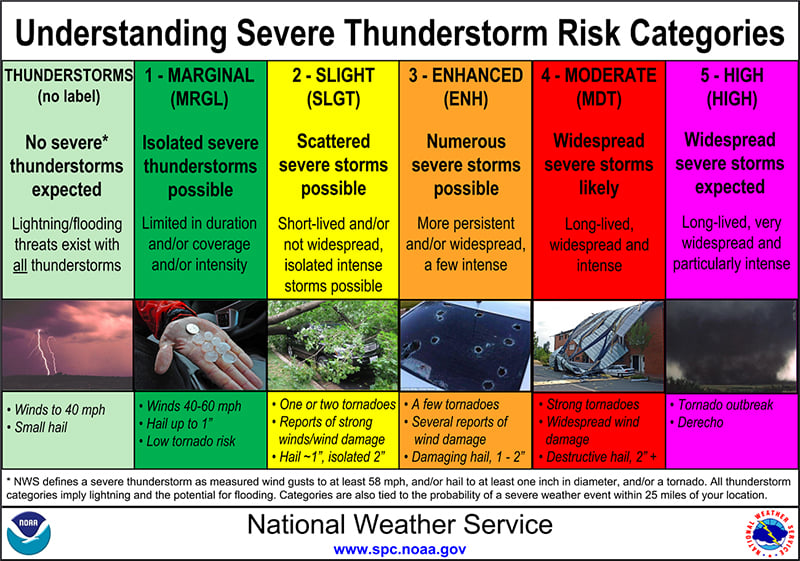
The intensity of thunderstorms can give you an idea of theintensity of a coming dust storm. (Source: National WeatherService)
|3. How intense are dust storms?
Haboobs are more intense than regular dust storms. Winds from 20to 70 mph can be up to 60 miles wide, 10,000 feet high, and last upto three hours with zero visibility.
|Although there is currently no scale to calculate the intensityof haboobs, the National Weather Service does have an intensityscale for thunderstorms that can give the public a sense of howstrong a coming dust storm might be.
|Related: New tool evaluates climate risk forinsurers
|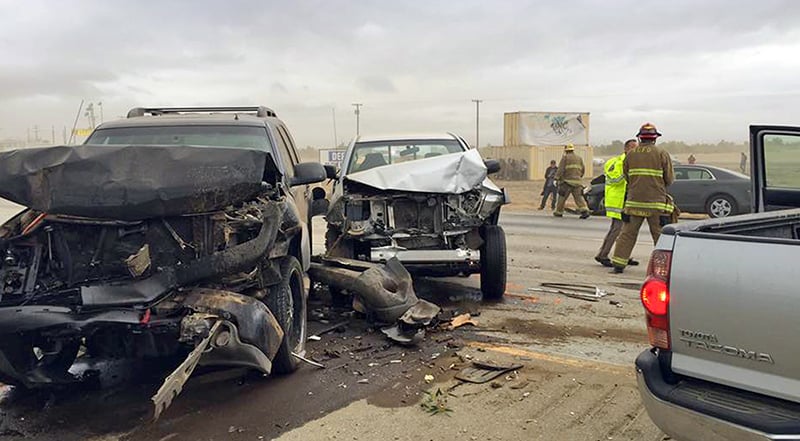
Firefighters are at the site of a 20-vehicle pileup onsouthbound U.S. Highway 99 in the southern San Joaquin Valley justsouth of Bakersfield, Calif., Nov. 2, 2015. Gusts of wind and rainwhipped up dust that dropped visibility to near zero. Five peoplewith minor injuries were taken to hospitals. (Kern County FireDepartment via AP)
|4. What kinds of damage can occur?
The potential damage from a dust storm or haboob can include thefollowing:
- Power failures.
- Utility damage.
- Airport closings.
- Turbulence.
- Motor vehicle accidents (especially chain-reactionaccidents).
- Roof and building damage.
- Exposure to valley fever.
- Asthma attacks.
Motorists are especially vulnerable to dust storms. TheNational Weather Service reported that one recent, rare duststorm affected central Illinois from mid-afternoon throughmid-evening, reducing visibility to near zero for several hours.The low visibility was responsible for numerous traffic accidentsand road closures, including I-72 from Jacksonville to Springfield,and I-74 from McLean to near Bloomington, and several state roadsacross Central Illinois.
|Related: Severe U.S. weather expected to cost insurers morethan $2B in March
|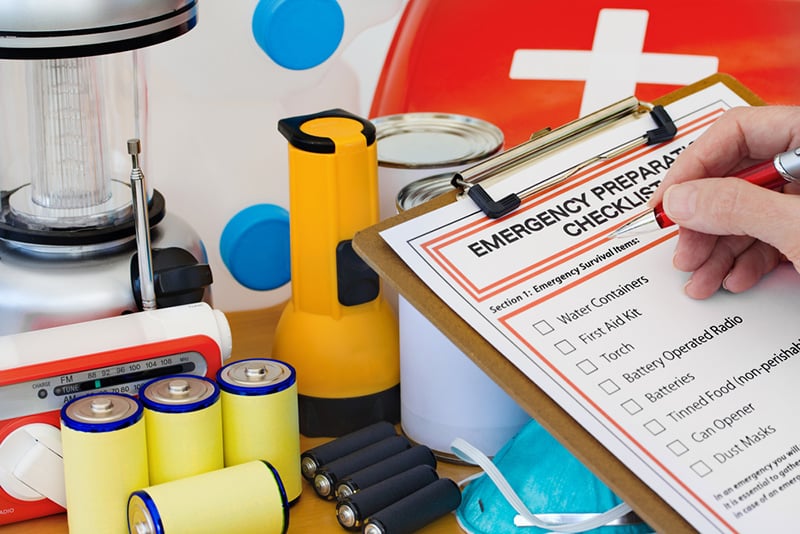
If you live in an area that's prone to dust storms,review your emergency kit regularly. (Photo: Shutterstock)
|5. What are some safety precautions totake?
Your safety preparations for dust storms and haboobs should besimilar to the precautions that you would take for severethunderstorms, tornadoes or other severe weather.
|One of the first steps is to have a weather alert app on your smartphone, especially if you livein or are traveling to a high-risk area. The University of Arizonahas created a warning app specifically for dust storms in thestate, available for iPhones and Android devices.
|And remember S-R-R-P:
|Secure = Close all doors, windows, vents, andany other airflow to the house.
|Remove = If you have time, remove things onyour property that could become flying debris.
|Respond = To storm warnings and warnings toremain indoors.
|Prepare = For disasters that can accompanyhaboobs such as monsoons, flooding, fires and power outages.
|Related: 6tips for staying connected this severe weather & hurricaneseason
|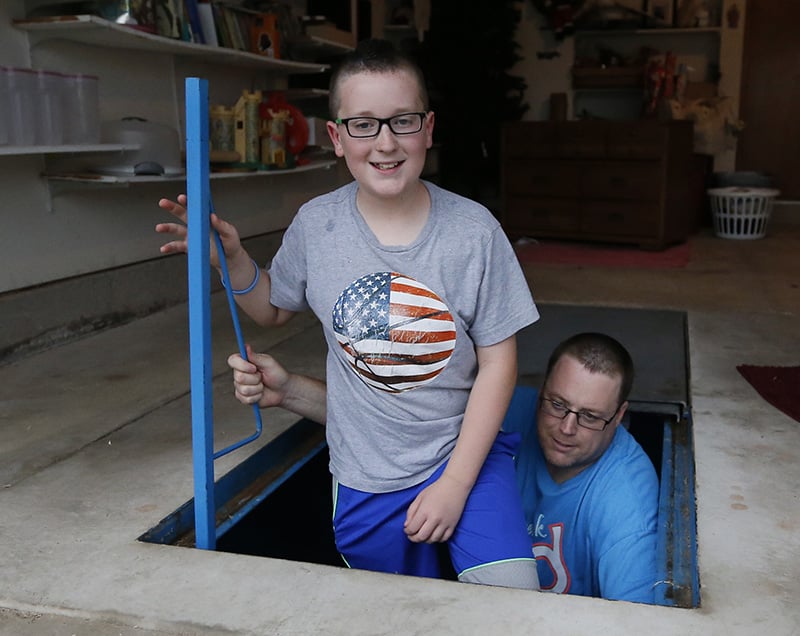
Gabriel Wheeler, left, and David Wheeler, right, pose for aphoto in their storm shelter in Oklahoma City, May 8, 2015. Wheelerhas the shelter stocked with blankets and flashlights. (APPhoto/Sue Ogrocki)
|6. What should I do if I'm at home when a duststorm hits?
If you're at home when a dust storm is expected, you shouldfollow these safety instructions:
- Close all your windows, curtains and blinds, and shut alldoors.
- Turn off fans or the air conditioning, or shut vents so thatdust doesn't come indoors.
- If the storm is severe, take shelter in a room without windows.It's important to stay away from windows because the wind can pickup rocks, tree limbs or other items that may shatter windows andcause injury.
Related: Oklahoma family gets keys to first FORTIFIEDHome™
|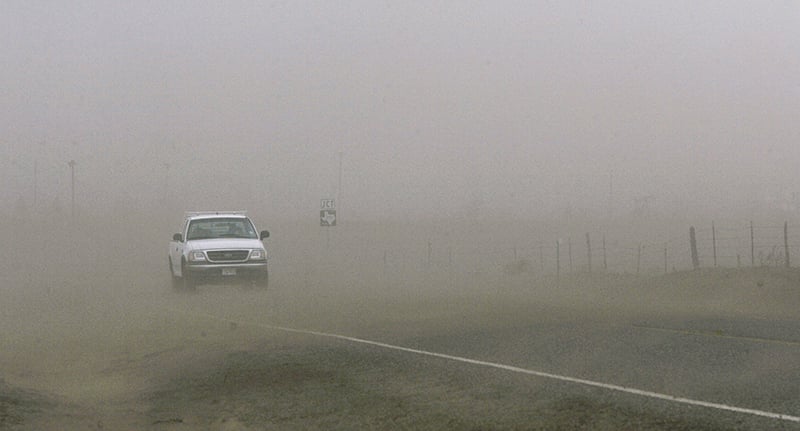
A truck makes its way down County Road 280 through a duststorm near Texroy, Texas, March 15, 2006. The high winds thatkicked up the storm threaten to rekindle wildfires that had beensweeping through the region. (AP Photo/Tony Gutierrez)
|7. What should I do if I'min my car?
If you're in your car or on the road while a dust storm isapproaching, follow these safety instructions:
- Safely pull off the road while you still have visibility.Do not stop in a travel or emergencylane.
- Turn off car headlights and interior lights so that othertravelers don't assume you are on the road and try to followyou.
- Make sure all windows are rolled up and doors are tightlyshut.
- Close air vents so dust doesn't come into the vehicle.
- Stay in your vehicle with seatbelts fastened and wait for thestorm to pass.
Related: 7 ways auto technology is impacting insurancecoverage
|Related: 10 windiest large U.S. cities
|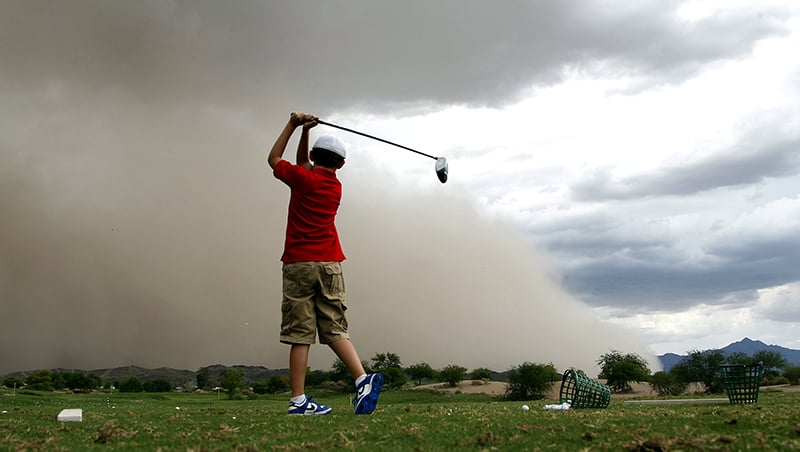
A lone golfer tries to get in a few more swings on thepractice range as a sand storm hits the Phoenix metro area Sunday,July 29, 2012, in Laveen, Ariz. (AP Photo/Ross D.Franklin)
|8. What should I do if I'moutdoors?
Dust storms are most common in the summer months when people areoften enjoying outdoor activities. You can stay safe from duststorms by following these tips:
- Get people and pets indoors as soon as possible.
- Avoid breathing the air directly if you can.
- Take cover from flying objects, the same way you would from atornado.
- Shield your eyes, nose and mouth. Cover your pet's eyes, noseand mouth as well.
Related: 10 windiest large U.S. cities
|
Michelle Perez, a customer care representative at theAmerican Red Cross store, unpacks and displays a two-personemergency preparedness kit in San Francisco, June 17, 2005. (APPhoto/Eric Risberg)
|9. What equipment should I have?
Start by keeping some means of getting alerts or warnings.They're often broadcast on radio and television, but you may not bewatching or listening when the alert is issued. You can get asmartphone app and sign up for your local government's emergencytext alerts.
|If you are relying on your smartphone as your main source ofcommunication, be sure it's fully charged and you have access tothe phone's charger as well as a back-up charging source.
|Be sure your home or office has the same kind of emergencyequipment that you would use in case of any power failure,including flashlights, a First Aid kit, a battery-operated AM/FMradio or one that receives all NOAA weather channels, and extrabatteries for all devices.
|You should also have a fire extinguisher as well as supplies tomanage any flooding that may occur with the storm.
|Finally, make sure you have bottled water and nonperishable foodon hand as well as blankets and foul-weather gear.
|Related: 6tips for staying connected this severe weather & hurricaneseason
|
A home and a car are damaged by an uprooted tree the dayafter a violent storm hit the area Aug. 19, 2011, in Eloy, Ariz.Homes were damaged, roofs were torn off businesses and a juniorhigh school had part of its roof missing. (AP Photo/Ross D.Franklin)
|10. What insurance coverage should Ihave?
Insurance coverage for property damage from dust storms orhaboobs varies by location and policy. For example, most homeowners' policies in Arizona do includecoverage for physical damage to structures because dust storms andhaboobs are so common.
|Personal property or contents inside the home is generally notcovered unless the force of winds associated with the haboob causean opening in a roof or wall allowing the dust or sand to enter theresidence. Personal property could be covered if residents have aseparate policy that insures just the contents.
|Business owners and owners of commercial property should checkwith their agents or brokers to determine what kind of coveragethey have for their property.
|Coverage for damage to motor vehicles should be similar todamage from hail or other types of weather, but this too varies bylocation and policy.
|Related: Does your homeowners' policy cover these threethings?
|Christine G. Barlow, CPCU is managing editorwith FC&S, a resource for insurance coverage analysis.She may be reached a [email protected]. Rosalie L. Donlon ismanaging editor of National Underwriter Property & Casualty.She may be reached at [email protected].
Want to continue reading?
Become a Free PropertyCasualty360 Digital Reader
Your access to unlimited PropertyCasualty360 content isn’t changing.
Once you are an ALM digital member, you’ll receive:
- All PropertyCasualty360.com news coverage, best practices, and in-depth analysis.
- Educational webcasts, resources from industry leaders, and informative newsletters.
- Other award-winning websites including BenefitsPRO.com and ThinkAdvisor.com.
Already have an account? Sign In
© 2024 ALM Global, LLC, All Rights Reserved. Request academic re-use from www.copyright.com. All other uses, submit a request to [email protected]. For more information visit Asset & Logo Licensing.








